The following approach to this problem uses 4 different classes: ForwardArrow, BackArrow, Slider, and ValueField. Arrow fill color is controlled by the press() method of its respective class.
color BLUE = color(64, 124, 188);
color LTGRAY = color(185, 180, 180);
color YELLOW = color(245, 250, 13);
color RED = color(255, 0, 0);
color BLACK = color(0, 0, 0);
color WHITE = color(255, 255, 255);
color GREEN = color(32, 175, 47);
ForwardArrow _fwdArrw;
BackArrow _backArrw;
ValueField _valueFld;
Slider _slider;
final int _sliderX = 90;
final int _sliderY = 40;
final int _sliderW = 200;
final int _sliderH = 30;
final int _txtSize = 22;
final int _initValue = 40;
final int _maxValue = 200;
final int _minValue = 0;
int value = _initValue;
class ValueField {
float x, y, w, h;
String title;
color fldColor;
color txtColor;
// Constructor
ValueField(int xpos, int ypos, float wt, float ht, String valueStr, color background, color foreground) {
x = xpos;
y = ypos;
w = wt;
h = ht;
title = valueStr;
fldColor = background;
txtColor = foreground;
}
void display(int val) {
// **** Value Field **** //
fill(fldColor); // erase old value
rect(x, y, w, h);
fill(txtColor); // text color
textSize(_txtSize);
textAlign(CENTER);
text(str(val), x, y, w, h);
// **** Slider bar **** //
fill(255);
rect(_sliderX, _sliderY, _sliderW*val/_maxValue, _sliderH);
}
}
class ForwardArrow {
float x, y, w, h;
color arrwColor;
// Constructor
ForwardArrow(int xpos, int ypos, float wt, float ht, color background) {
x = xpos;
y = ypos;
w = wt;
h = ht;
arrwColor = background;
}
void display() {
fill(arrwColor); // arrow color
noStroke();
triangle(x, y, x, y + h, x + w, y + h/2 );
}
void press() {
fill(255); // arrow color
noStroke();
triangle(x, y, x, y + h, x + w, y + h/2 );
}
}
class BackArrow {
float x, y, w, h;
color arrwColor;
// Constructor
BackArrow(int xpos, int ypos, float wt, float ht, color background) {
x = xpos;
y = ypos;
w = wt;
h = ht;
arrwColor = background;
}
void display() {
fill(arrwColor);
noStroke();
triangle(x, y + h/2, x + w, y, x + w, y + h );
}
void press() {
fill(255);
noStroke();
triangle(x, y + h/2, x + w, y, x + w, y + h );
}
}
class Slider {
float x, y, w, h;
color barColor;
color trimColor;
// Constructor
Slider(int xpos, int ypos, float wt, float ht, color background, color foreground) {
x = xpos;
y = ypos;
w = wt;
h = ht;
barColor = background;
trimColor = foreground;
}
void display() {
stroke(0);
strokeWeight(1);
noFill();
rect(x, y, w, h);
}
}
void setup() {
size(500, 250);
background(BLUE);
_slider = new Slider(_sliderX, _sliderY, _sliderW, _sliderH, WHITE, BLACK);
_backArrw = new BackArrow(50, 40, 30, 30, GREEN);
_fwdArrw = new ForwardArrow(300, 40, 30, 30, GREEN);
_valueFld = new ValueField(380, 40, 60, 30, str(_initValue), WHITE, BLACK);
}
void draw() {
background(BLUE);
_valueFld.display(value);
_fwdArrw.display();
_backArrw.display();
_slider.display();
// FwdArrw Long Press
if ((mouseX >= _fwdArrw.x) && (mouseX <= _fwdArrw.x + _fwdArrw.w) && (mouseY >= _fwdArrw.y) && (mouseY <= _fwdArrw.y + _fwdArrw.h)) {
if (mousePressed == true) {
_fwdArrw.press();
value++;
if (value > _maxValue) {
value = _maxValue;
}
_valueFld.display(value);
}
}
// BackArrw Long Press
if ((mouseX >= _backArrw.x) && (mouseX <= _backArrw.x + _backArrw.w) && (mouseY >= _backArrw.y) && (mouseY <= _backArrw.y + _backArrw.h)) {
if (mousePressed == true) {
_backArrw.press();
value--;
if (value < _minValue) {
value = _minValue;
}
_valueFld.display(value);
}
}
}
A revision of your code follows;
int x=75;
void setup() {
size(600, 400);
}
void draw() {
background(100);
fill (200);
rect (75, 25, 400, 50); // slider bar
stroke(0);
fill(127, 0, 0);
rect (x, 20, 9, 60); // slider thumb
fill (200);
rect (10, 25, 50, 50); // back arrow
fill(0);
triangle (50, 60, 50, 40, 15, 50);
if ((mouseX >= 10) && (mouseX <= 10 + 50) && (mouseY >= 25) && (mouseY <= 25 + 50) ) {
if (mousePressed == true) {
fill(255);
triangle (50, 60, 50, 40, 15, 50);
x--;
if (x<75) {
x = 75; // minValue
}
} else {
fill(0);
triangle (50, 60, 50, 40, 15, 50);
}
}
fill (200);
rect (490, 25, 50, 50); //forward arrow
fill(0);
triangle (500, 60, 500, 40, 535, 50);
if ((mouseX >= 490) && (mouseX <= 490 + 50) && (mouseY >= 25) && (mouseY <= 25 + 50) ) {
if (mousePressed == true) {
fill(255);
triangle (500, 60, 500, 40, 535, 50);
x++;
if (x>466) {
x = 466; // maxValue
}
} else {
fill(0);
triangle (500, 60, 500, 40, 535, 50);
}
}
}
